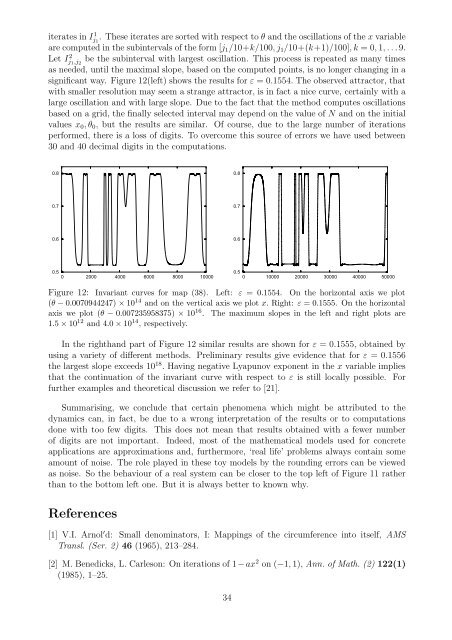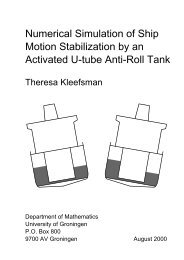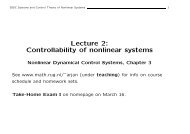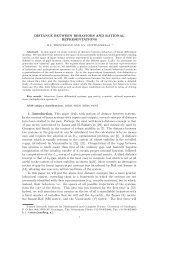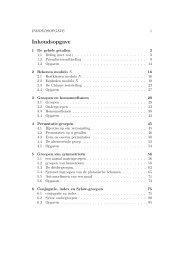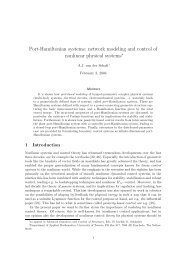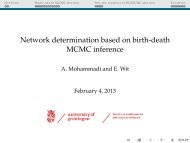Chaos and quasi-periodicity in diffeomorphisms of the solid torus
Chaos and quasi-periodicity in diffeomorphisms of the solid torus
Chaos and quasi-periodicity in diffeomorphisms of the solid torus
You also want an ePaper? Increase the reach of your titles
YUMPU automatically turns print PDFs into web optimized ePapers that Google loves.
iterates <strong>in</strong> Ij 1 1<br />
. These iterates are sorted with respect to θ <strong>and</strong> <strong>the</strong> oscillations <strong>of</strong> <strong>the</strong> x variable<br />
are computed <strong>in</strong> <strong>the</strong> sub<strong>in</strong>tervals <strong>of</strong> <strong>the</strong> form [j 1 /10+k/100, j 1 /10+(k+1)/100], k = 0, 1, . . . 9.<br />
Let Ij 2 1 ,j 2<br />
be <strong>the</strong> sub<strong>in</strong>terval with largest oscillation. This process is repeated as many times<br />
as needed, until <strong>the</strong> maximal slope, based on <strong>the</strong> computed po<strong>in</strong>ts, is no longer chang<strong>in</strong>g <strong>in</strong> a<br />
significant way. Figure 12(left) shows <strong>the</strong> results for ε = 0.1554. The observed attractor, that<br />
with smaller resolution may seem a strange attractor, is <strong>in</strong> fact a nice curve, certa<strong>in</strong>ly with a<br />
large oscillation <strong>and</strong> with large slope. Due to <strong>the</strong> fact that <strong>the</strong> method computes oscillations<br />
based on a grid, <strong>the</strong> f<strong>in</strong>ally selected <strong>in</strong>terval may depend on <strong>the</strong> value <strong>of</strong> N <strong>and</strong> on <strong>the</strong> <strong>in</strong>itial<br />
values x 0 , θ 0 , but <strong>the</strong> results are similar. Of course, due to <strong>the</strong> large number <strong>of</strong> iterations<br />
performed, <strong>the</strong>re is a loss <strong>of</strong> digits. To overcome this source <strong>of</strong> errors we have used between<br />
30 <strong>and</strong> 40 decimal digits <strong>in</strong> <strong>the</strong> computations.<br />
0.8<br />
0.8<br />
0.7<br />
0.7<br />
0.6<br />
0.6<br />
0.5<br />
0 2000 4000 6000 8000 10000<br />
0.5<br />
0 10000 20000 30000 40000 50000<br />
Figure 12: Invariant curves for map (38). Left: ε = 0.1554. On <strong>the</strong> horizontal axis we plot<br />
(θ − 0.0070944247) × 10 14 <strong>and</strong> on <strong>the</strong> vertical axis we plot x. Right: ε = 0.1555. On <strong>the</strong> horizontal<br />
axis we plot (θ − 0.007235958375) × 10 16 . The maximum slopes <strong>in</strong> <strong>the</strong> left <strong>and</strong> right plots are<br />
1.5 × 10 12 <strong>and</strong> 4.0 × 10 14 , respectively.<br />
In <strong>the</strong> righth<strong>and</strong> part <strong>of</strong> Figure 12 similar results are shown for ε = 0.1555, obta<strong>in</strong>ed by<br />
us<strong>in</strong>g a variety <strong>of</strong> different methods. Prelim<strong>in</strong>ary results give evidence that for ε = 0.1556<br />
<strong>the</strong> largest slope exceeds 10 18 . Hav<strong>in</strong>g negative Lyapunov exponent <strong>in</strong> <strong>the</strong> x variable implies<br />
that <strong>the</strong> cont<strong>in</strong>uation <strong>of</strong> <strong>the</strong> <strong>in</strong>variant curve with respect to ε is still locally possible. For<br />
fur<strong>the</strong>r examples <strong>and</strong> <strong>the</strong>oretical discussion we refer to [21].<br />
Summaris<strong>in</strong>g, we conclude that certa<strong>in</strong> phenomena which might be attributed to <strong>the</strong><br />
dynamics can, <strong>in</strong> fact, be due to a wrong <strong>in</strong>terpretation <strong>of</strong> <strong>the</strong> results or to computations<br />
done with too few digits. This does not mean that results obta<strong>in</strong>ed with a fewer number<br />
<strong>of</strong> digits are not important. Indeed, most <strong>of</strong> <strong>the</strong> ma<strong>the</strong>matical models used for concrete<br />
applications are approximations <strong>and</strong>, fur<strong>the</strong>rmore, ‘real life’ problems always conta<strong>in</strong> some<br />
amount <strong>of</strong> noise. The role played <strong>in</strong> <strong>the</strong>se toy models by <strong>the</strong> round<strong>in</strong>g errors can be viewed<br />
as noise. So <strong>the</strong> behaviour <strong>of</strong> a real system can be closer to <strong>the</strong> top left <strong>of</strong> Figure 11 ra<strong>the</strong>r<br />
than to <strong>the</strong> bottom left one. But it is always better to known why.<br />
References<br />
[1] V.I. Arnol ′ d: Small denom<strong>in</strong>ators, I: Mapp<strong>in</strong>gs <strong>of</strong> <strong>the</strong> circumference <strong>in</strong>to itself, AMS<br />
Transl. (Ser. 2) 46 (1965), 213–284.<br />
[2] M. Benedicks, L. Carleson: On iterations <strong>of</strong> 1−ax 2 on (−1, 1), Ann. <strong>of</strong> Math. (2) 122(1)<br />
(1985), 1–25.<br />
34


